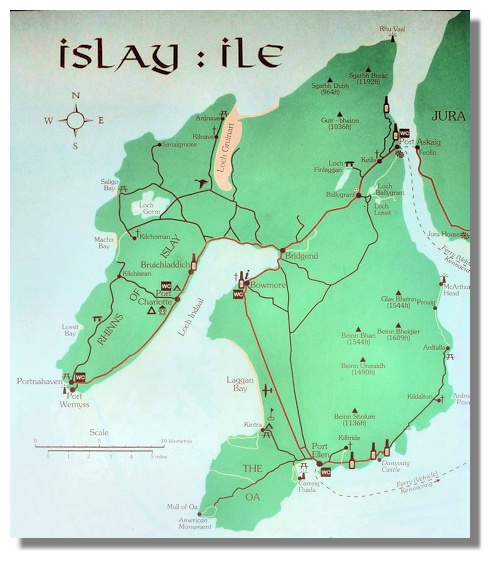
Places to Visit in Scotland
- Flying Visit to Islay

Background
Last year, my daughter and I flew to Stornoway and spent the day driving around Lewis before flying back to Glasgow in the evening - see Whirlwind Tour of Lewis for an account of that journey. We thoroughly enjoyed the trip - and I added 275 photographs to my library collection! So we thought we should repeat the format on another Scottish island and Islay seemed to fit the bill with an early morning departure from Glasgow airport, a hired car and a whistle-stop tour of the island before catching an early evening flight back home.
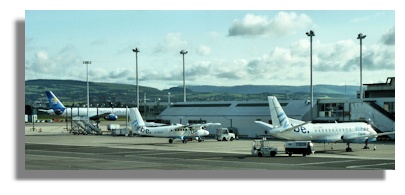
Getting to Islay
During my career in banking I frequently had to catch the "red eye" flight at 7am to London to attend meetings there that started at 10am. But these days my alarm clock is more likely to start ringing at 9am or even after. So, even with the benefit of online check-in it was a shock to have to set the alarm went off at 5am so we could get to the airport in time for the early morning flight to Islay.

The day we were travelling was also the first day of the school summer holidays so Glasgow airport was busier than usual. But we flew through security and even had time for a cup of coffee and some photos of the aircraft on the apron outside before boarding the flight to Islay on a small twin-turbo-prop Saab Scania SF340 operated by budget airline Fly-Be on behalf of Loganair. The scattered cloud below allowed us glimpses of the land and water below as we passed over the river Clyde (getting a picture of the Erskine Bridge across the river that we had driven across on the way to the airport).
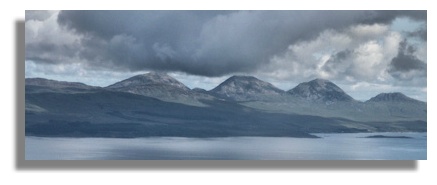
The flight only took about 30 minutes and soon we were below the clouds on our way to the only airport on Islay. We got glimpses of the mountains on the isle of Jura, north of Islay and then several whisky distilleries on the south coast of Islay before touching down. There were obviously other tourists like ourselves who were taking pictures of the aircraft as we walked to the small terminal building (also known as Glenegedale Airport, after the nearby village). Our rental car - a small Volkswagen Golf - was waiting for us in the small car park outside.
Bowmore
The road past Islay airport runs as straight as an arrow north and south past the airport and we had decided to leave the southern part of the island to later - just in case we didn't have time. Islay, with a total population of around 3,500 doesn't have anything big enough to be called a "town" but our first stop was Bowmore, a pretty village with wide streets overlooking Loch Indaal. It is the largest conurbation on the island and could be regarded as the island's capital. Construction of Bowmore began in 1770, just after the completion of the Kilarrow Parish Church, which was built in a circular shape - apparently to prevent the devil from hiding in a corner...
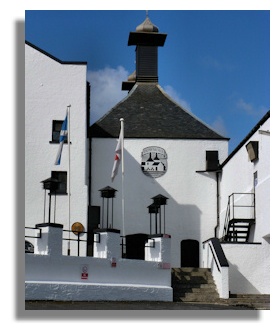
I had planned to call in at all the distilleries on Islay and buy a miniature bottle of their single malt whisky, so we went into the smart visitor reception area at the Bowmore distillery (which came into operation at some time before 1816) and is situated on the shores of Loch Indaal. My plan was initially thwarted by the Scottish licensing laws - it was before 10am and it is not permitted to sell alcohol as early as that! Fortunately, our route meant that we would be passing through Bowmore later in the day and could legally purchase the miniature bottle then.
Around Loch Indaal
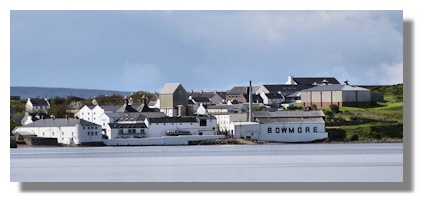
Loch Indaal is a sea loch that sweeps round from south of Bowmore on the east to beyond Port Charlotte on the west. It was good to be able to take a picture of Bowmore distillery from the other side of the loch. At night, the lights of the villages on the other side twinkle in the dark and inspired a well-known folk song "The Lights of Lochindaal".
Our first stop was Bruichladdich distillery. Depending on accent, Bruichladdich can be pronounced "brook-lad-dee" or "broo-ee-clah-dee." The distillery was built in 1881 and was a state-of-the-art design when it was built, with a very efficient layout, built around a large, spacious courtyard. The distillery was featured in an episode of a BBC2 series "Oz and James Drink to Britain," in which the presenters were given a tour of the distillery and allowed to try some of the prized 'X4', quadruple-distilled "Perilous Whisky", of which Gaelic writer MÓrtainn MacGilleMhÓrtainn wrote in 1695 "the first taste affects all the members of the body; two spoonfuls of this last liquor is a sufficient dose; and if any man exceed this, it would presently stop his breath, and endanger his life." During the programme, the BBC presenters not only drank it but used the ultra pure spirit to run a racing car!Bruichladdich distillery has a series of webcams which beam their pictures on the Internet. These webcams were the focus of an intelligence operation by the American Defense Threat Reduction Agency when the antique distilling equipment was mistaken for that purportedly used for Iraq's elusive WMD chemical weapons! This story has roots in an e-mail sent by a concerned American agent to the distillery when one of the webcams had broken - they had apparently been observing the pictures carefully until then...
Further down the coast, we passed the Museum of Islay Life on the outskirts of Port Charlotte. Located in a former church the museum is surrounded by grave stones which seemed to be at variance with its name!
Port Charlotte itself was a charming village, overlooking Loch Indaal and with most of the buildings sparkling with white painted walls. Port Charlotte was named after the wife of Lord Frederick Campbell and was set up mainly to provide housing facilities for the Lochindaal Distillery workers. That distillery is now closed but one at Port Charlotte Distillery is scheduled to be reopened in the near future.
The road continues down the coast of the Rinns of Islay peninsula to Portnahaven. The harbour there is sheltered by the island of Orsay and the Rinns of Islay lighthouse on the island was built by the famed lighthouse engineer Robert Stevenson (he also built the Bell Rock Lighthouse among many others). We didn't have time to go that far so retraced our steps to Bridgend at the top of Loch Indaal. There we stopped off for coffee and biscuits at the charming, 160-year-old Bridgend Hotel, taking them up on the suggestion to have our "elevenses" sitting out in their attractive garden in the sunshine.
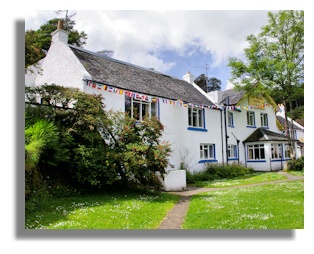
Bridgend to Port Askaig
Refreshed by our stop at the Bridgend Hotel, we then headed north across Islay to Port Askaig, travelling along good roads through moorland scenery, with the mountains on the neighbouring island of Jura coming ever closer. The modern name "Jura" dates from the Norse-Gael era and is from the Old Norse "Dyr°y" meaning "deer island". With only 188 inhabitants recorded in the 2001 census, Jura is even less densely populated than neighbouring Islay and is one of the least densely populated islands of Scotland.
Port Askaig is regarded as the main port of Islay, sharing passenger services to the Scottish mainland with Port Ellen in the south. It also has a regular service to Jura across the Sound of Islay, and in the summer there is also a weekly service via Colonsay to Oban. Even so, there are not many buildings apart from the Port Askaig hotel, a petrol station and shop.
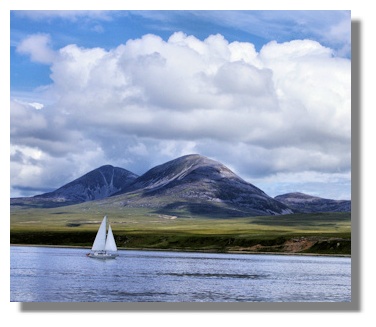
We had considered taking the ferry over to Jura but one of the main tourist attractions there is Jura House which has famous and beautiful walled gardens that benefit from a southerly aspect and the effects of the Gulf Stream. The gardens are home to exotic specimen plants from Australasia, and have for some years been a popular tourist attraction on the island. In November 2010 Jura House and the associated estate was bought by an Australian hedge-fund manager. Although he has yet to visit his acquisition, he instructed that the gardens should be closed to the public. So we decided not to take the short trip over to Jura. Instead, we called in at Port Askaig Hotel for a snack lunch - we were the only customers there at the time.
Jura is dominated by three steep-sided conical mountains ľ the Paps of Jura - the tallest of which is Beinn an Ďir (Gaelic for mountain of gold) standing at 2,575 feet (785 m), and is thus a "Corbett" (a Scottish term for hills between 2500-3000 feet).
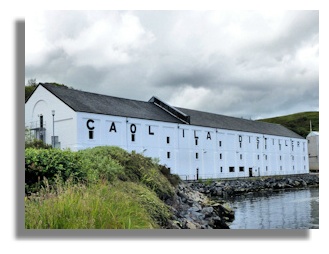
Caol Ila and Bunnabhain
Still on my mission to call in at all the distilleries on Islay, we left Port Askaig and headed for Caol Isla distillery, along a narrow, single track road. Caol Isla is derived from Gaelic Caol ╠le or "Sound of Islay". It was founded in 1846 but in 1972 the entire structure of the distillery was demolished. A larger distillery was built in the same original architectural style, and production resumed in 1974. Caol Ila is one of the lighter Islay whiskies and in addition to being sold as a single malt, it is used heavily in blends such as Johnnie Walker and Black Bottle. Disappointingly for my objective of buying a miniature from all the distilleries, there was a locked gate across the road to the buildings and there didn't seem to be any distillery visitor centre where I could make a purchase.
The next port of call on our "distillery crawl" was Bunnahabhain (pronounced Boon-a-havn). The village there was established in 1881 to house the distillery's workers, and the distillery still employs the majority of the village's working population. Initially, I thought that it too didn't have a visitor centre, but after wandering between the distillery buildings I eventually found a small sales office where I could make my purchase.
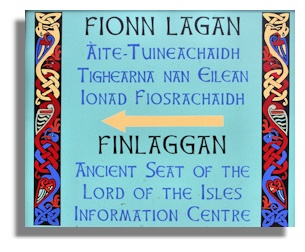
Finlaggan
On the way back from Port Askaig, we took another detour, this time along the track leading to Finlaggan, once the seat of the "Lord of the Isles" and regarded as the ancestral home of Clan Donald. Two of the three islands that lie in Loch Finlaggan, Eilean Mor (large island) and Eilean na Comhairle (council isle), were the ancient administration centre of the Lordship of the Isles during mostly the 13th, 14th and 15th centuries.
The Macdonald Lords of the Isles were descended from Somerled, a 12th century prince, one of the Viking invaders from Norway. These lords, the chiefs of Clan Donald, chose Finlaggan as their home and the centre of their lordship, so that Islay is often referred to as the Cradle of Clan Donald. The Lords of the Isles ruled the islands and part of the west coast of Scotland, from Kintyre to Lewis, virtually independent of royal control.
The site is maintained by the Finlaggan Trust who have built timber walkways and paths across the marshy ground from the shore to Eilean M˛r (Big Island) where there are the remains of ancient buildings including a "Great Hall" and a 14th century chapel dedicated to St. Findlugan. Several 16th century graves have been put on display and covered by large protective glass panels.
The Finlaggan Trust has also refurbished a derelict cottage that has been converted into a comprehensive museum containing numerous artefacts discovered during archaeological excavations. The Trust has also provided a lot of good information panels around the site.During the morning the weather had been kind to us with plenty of blue skies with fluffy clouds but by the time we had got to Finlaggan a solid blanket of cloud had rolled in, but at least it remained dry all day.
Port Ellen, Laphroaig, Lagavulin and Ardbeg
Making sure that we stopped off at Bowmore distillery on the way, to buy that missing miniature malt, we now headed to the distilleries on the south coast of Islay, passing the airport gates on the way. The first of these was at Port Ellen, named after the wife of the founder, Frederick Campbell of Islay. It was previously named Le˛damas, derived from old Norse meaning "Le˛d's Harbour". Port Ellen is built in a semi-circle around Loch Leodamais, Islay's main deep water harbour. Port Ellen is the second largest town on Islay, only slightly smaller than Bowmore. The distillery there ceased production of whisky in 1983. But the large malting (the process of converting barley into malt) continues to produce for the majority of the distilleries on Islay.
Further along the coast is Laphroaig (pronounced la-froyg, with the emphasis on the second syllable) and the distillery there was established in 1815. It subsequently became part of Allied Domecq but the brand was acquired by Fortune Brands in 2005. Laphroaig is the only whisky to carry the Royal Warrant of the Prince of Wales. The 15-year-old Laphroaig is reportedly the prince's favourite Scotch whisky and so his crest - the Prince of Wales Feathers - adorns the wall of the building. The distillery has an attractive visitor centre which seems to attract a lot of visitors.
A short distance along the coast is Lagavulin. The distillery there dates from 1816 though, as with a number of other distilleries, illicit distillation took place there from at least the 18th century. Lagavulin Single Malt has a strong peat flavour and iodine overtones which tends to divide tasters into love it or hate it groups with no middle ground. It was probably Lagavulin that made me dislike Islay whisky many years ago. Even so, I wanted to buy a miniature to add to the collection to take home. The well appointed shop disdained such small bottles and the smallest they had was 20 centilitres. With some hesitation, I bought the bottle after calculating that the larger bottle was better value for money. Little did I realise the problem that decision was to cause....
Just off the coast from Lagavulin is an island on which stands the ruins of Dunyvaig Castle (from Scottish Gaelic "Dun Naomhaig", or Fort of the Galleys in English). The castle was once a naval base of the Lord of the Isles, chiefs of Clan Donald and was held by the chiefs of the Clan MacDonald of Dunnyveg. The castle was forfeited in 1493 and later in the 17th century the castle passed into the hands of the Campbells of Cawdor, who held it until 1677, when Sir Hugh Campbell destroyed the castle and moved to Islay House. The owners of the Lagavulin Distillery (United Distillers) carried out repairs to the castle in 1998, aided by a grant from Historic Scotland. This kept the castle from crumbling further.
The last distillery on that southern coast of Islay was Ardbeg. Perhaps because it is the furthest distance to travel to get there, Ardbeg has made a big effort to create an attractive place for visitors with tours of the distillery as well as a large restaurant area.
Getting Home
We arrived back at the airport terminal in plenty of time for our flight and had coffee and some snacks in the waiting area. We were well satisfied with our successful tour of the island - and my miniature bottles of whisky were clinking together in my hand luggage. It was when our flight was called and we sauntered over to the security check that things began to go downhill... First of all, the machine to read our on-line check-in documents had broken down - and the "back-up" system involved dashing back to the Fly-Be check-in desk to get them to issue an ordinary boarding pass. Back at the security check, that 20 centilitre bottle of Lagavulin was double the amount of fluid allowed by the current regulations in hand luggage on all flights. There was no way of consuming enough of the bottle on the spot - even if I hadn't my car waiting at Glasgow airport. Fortunately, the staff had clearly dealt with similar situations before and suggested that it could be put in the hold - without us having to return to the check-in desk. I had visions of having a lengthy wait for it at the carousel in the arrivals hall at Glasgow. But when we arrived there after our flight it immediately appeared with its identification label round its neck, ahead of all the other luggage!
After we got home, I took photos of all the miniature bottles (for future use as illustrations) and my daughter took the miniature bottles with her back south to Stansted airport - obviously having to leave behind that larger bottle of Lagavulin. Later, I decided to risk trying that 16-year-old Lagavulin single malt - and found to my surprise that it was to my liking; perhaps my taste for such beverages had "matured" in the intervening years since I had first tried an Islay malt? So, as they say, "all's well that ends well!"Video Slide Show
I've taken a large number of the pictures taken during this trip to Islay and created a video slide show of these on YouTube at Islay Tourisat Guide.
Return to Index of Places to Visit
Where else would you like to go in Scotland?

